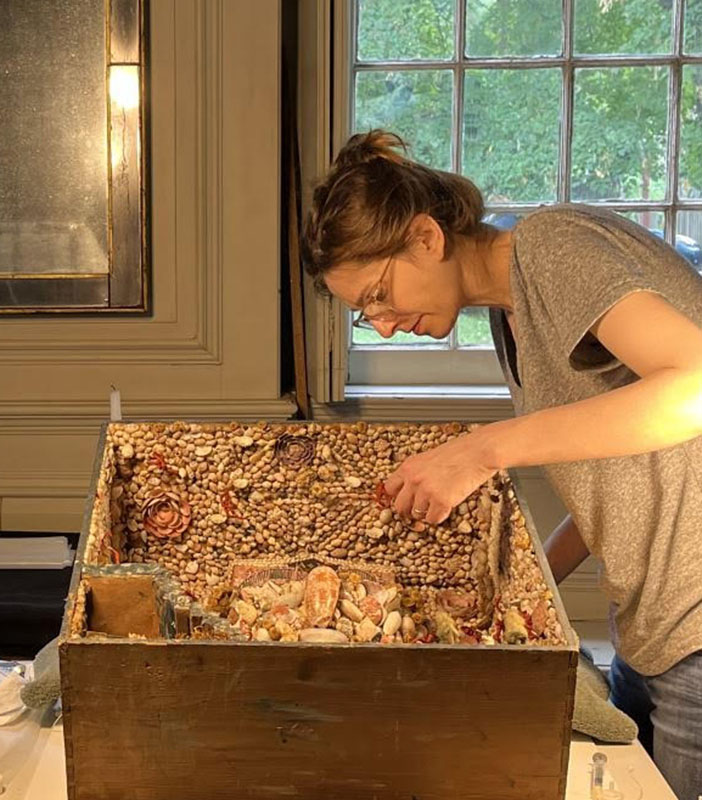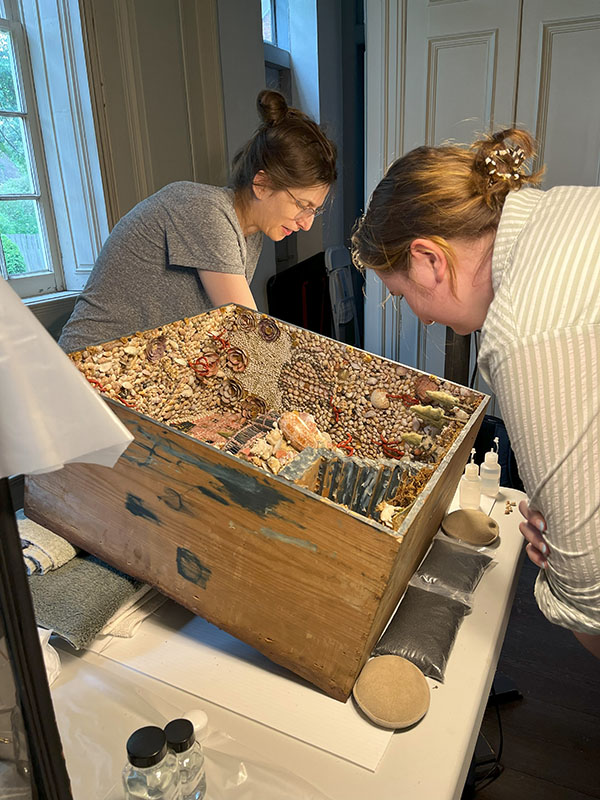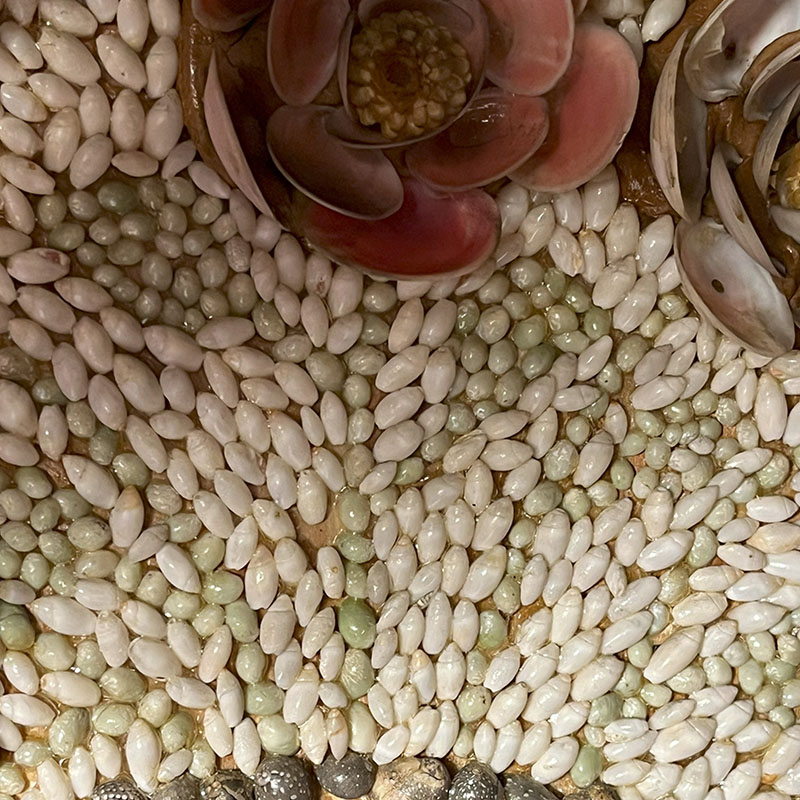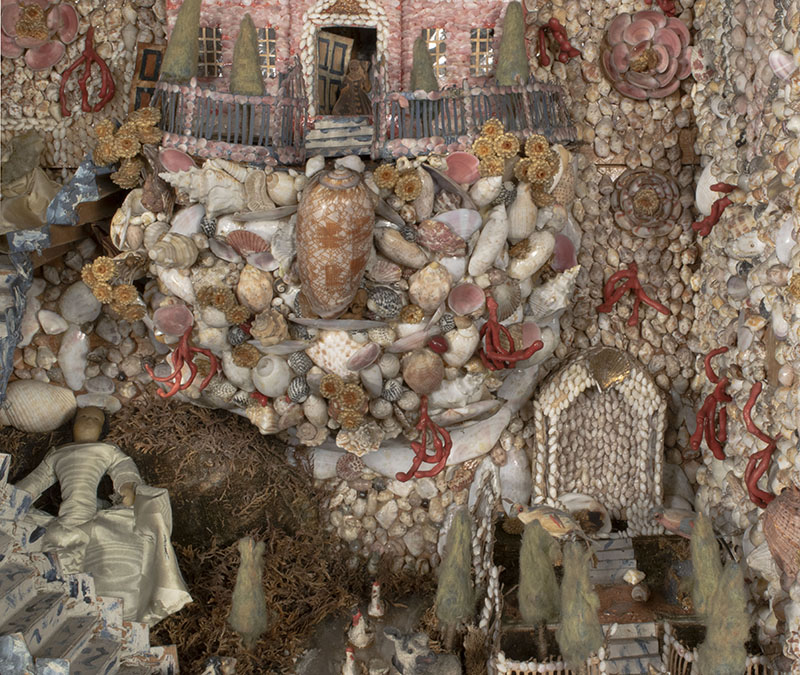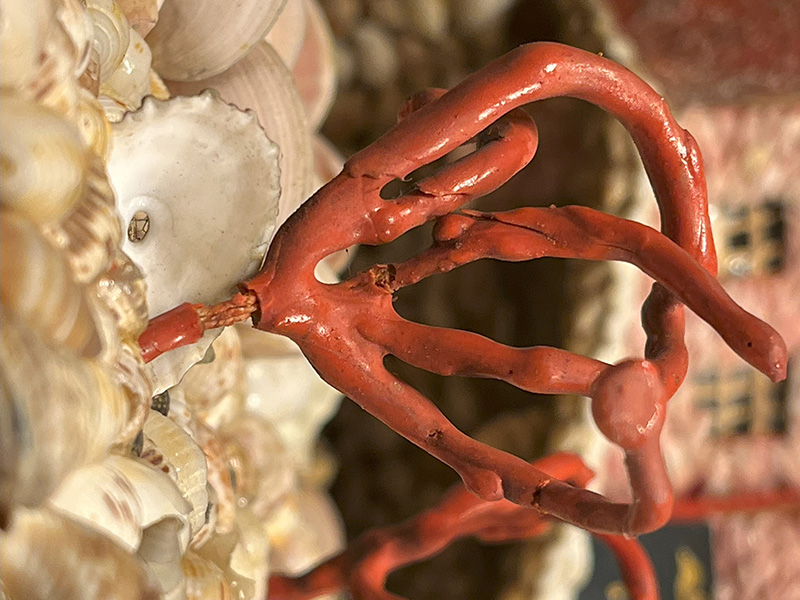“A Place to Cultivate her Mind in by Musing”: New Exploration of Anne Emlen’s 1757 Shellwork Grotto
by Kaila Temple
In a large brick house across from the Pennsylvania State House, perhaps in a parlor, sits a woman intently working on a large wooden box. Spread before her are hundreds of small shells, sorted by color and type. Carefully, she selects the shell that fits her picture and nestles it in line with others like it, secured with glue. Using the now-empty homes of tiny mollusks, she crafts miniature facsimiles of the built and natural world. Tiny pink bivalves become rows of brick with their larger purple relatives making up flowers. Tiny green snails create stems and leaves. Small white olive shells, not dissimilar in appearance to grains of rice, are carefully tiled together to create lines and patterns, slowly covering the surface. A mirrored glass pond is carefully glued to the bottom of the box, and dried moss arranged over green velvet creates a verdant carpeting. Painted paper becomes dark blueish marble, and wool batting forms carefully manicured topiaries. She populates her miniature world with dogs, rabbits, sheep, and birds. Wax dolls are gently nestled into the scene, adding a human presence. Dipping her brush in gold paint, she inscribes her initials, “A.E.,” on the house cornice with the date, 1757. Once the final shell is placed, she will slide her masterpiece into its tightly fitted, glass-fronted case, where it will remain for over 250 years.
Anne Reckless Emlen’s (1720–1816) creation (figure 1), referred to by scholars and museum staff over the years as a grotto box or shell box, is an object in which one can easily get lost. The wonders of its complexity and depth have fascinated Stenton stewards and visitors for over one hundred years. Anne was related to the Logans of Stenton by marriage, sister-in-law to William Logan via his marriage to Hannah Emlen. The box descended in the Logan family until Samuel Betton bequeathed it to Stenton’s collection in 1915. The box represents a small but fascinating category of women’s creative production in colonial Philadelphia and is one of only several such boxes known. The most similar grotto to Stenton’s is in the collection of Colonial Williamsburg, with other notable examples at Winterthur and the Chester County History Center.
Stenton’s curatorial team recognized that the effects of age were taking a toll on the grotto. The moss at the bottom was littered with a number of fallen shells. A large crack to the glass of the case, previously stabilized in 1994, required attention. This year, with funding from the Decorative Arts Trust’s Dean F. Failey Grant, Stenton embarked on a conservation project to stabilize the box, and, in the process, to reveal more of its secrets.
Winterthur objects conservator Lara Kaplan cleaned, stabilized, and reglued shells and other materials (figures 2 and 3), like the dangling wax-coated “corals.” She repaired the unsightly large crack in the original crown glass with a Hextall epoxy. The conservation process began with Stenton’s staff carefully removing the interior box from its outer glazed case. The extended months of well-lit close looking and study yielded new insights and avenues of research regarding the materials, creation, and global connections intrinsic to this extraordinary object.
The Atlantic white cedar box containing the grotto is built like a dovetailed drawer. The outer case is similarly constructed, open on one side and sealed on the front with glass, secured with window glazing behind a simple molded frame. The exterior of the outer case is painted entirely black. Emlen or her husband George (1718–76) likely purchased or ordered the case from a Philadelphia craftsman. A 1767 ad placed by house painter and glazer Robert Kennedy states that he provided “[s]hell and [w]ax [w]ork boxes, of the neatest [k]ind, fit for [l]adies,” as well as framed and glazed prints and maps.1
Where Emlen may have purchased the shells is less clear. Advertisements for the sale of shells in mid-18th-century Philadelphia are scarce. Shellwork was certainly present in the city, whether for viewing at public venues or taught at schools for girls.2 Teachers of shellwork had access to the requisite materials, and likely purchased shells in volume to distribute to students and lady crafters. One of the few advertisements for shells from the Pennsylvania Gazette announced the availability of “a neat collection of foreign [s]hells, set for [grottos] or any other [s]hell work.”3
On closer examination of the shells used in the grotto, several easily identified species offer insight into the shipping routes that brought the mollusks to Philadelphia. Small emerald nerites (Smaragdia viridis), a species of sea snail known for their bright green color, form stems and leaves on the sides of the box (figure 4). Juvenile queen conchs (Aliger gigas), checkered nerite (Nerita tessellata), Atlantic thorny oyster (Spondylus americanus), and pink tellins (Tellina lineata), all with ranges from North Carolina through the Caribbean islands, are also easily identified. Likely harvested as empty through beachcombing, many of these shells are small, representing the naturally high juvenile mortality rates of marine mollusks. The sole Pacific shell (figure 5) is the large tent olive (Oliva porphyria), a sea snail found on the coast of central and south America from western Mexico to Peru. Unlike the other shells in the grotto, this nocturnal mollusk was likely harvested alive, killed, and removed from its shell to be sold.4
The central placement of this shell may indicate Emlen’s understanding of its comparative rarity and value as an object of decorative and scientific interest. Tent olive shells can be found in 18th-century shell collections as specimens of interest to taxonomists and natural historians and were frequently mounted in silver for snuff boxes.5 Was Emlen sorting and arranging her larger specimen shells with attention to their rarity and quality as representative specimens of individual species of shells? Her central placement highlighting the tent olive and other species not used elsewhere in the box certainly indicates a sort of hierarchical thinking within the array of her materials. The popularity of taxonomy and natural history as appropriate and fashionable interests for women in the mid-18th century might suggest that Emlen considered aesthetics and the ordering of nature as she placed her shells.
Closer examination of Emlen’s materials also yielded substantial links to period didactics on women’s craft work. Emlen’s shell mosaic is punctuated by bright red faux coral that imitated the valuable red branch coral frequently used in jewelry. The Young Lady’s School of the Arts by Hannah Robertson provides instructions for “[a]rtificial [c]oral for [g]rotto-work,” a mixture of rosin and vermillion to coat twigs “in imitation of nature.”6 Damage to the “coral” in the grotto revealed bundles of thread underneath the wax coating (figure 6). Robertson suggests blackthorn twigs specifically, a European tree not yet naturalized in Pennsylvania in the 18th century. North American grotto makers such as Emlen would have used their best judgment in finding a substitute. The Young Lady’s School of the Arts also included a recipe for a “cement” consisting of rosin, beeswax, “stone-flour,” and “[sulfur] flour,” combined over heat and kneaded in warm water.7 These ingredients may be the same for the cement Anne used to build the rose-like flowers she set on the walls and ceiling of the grotto box. Sample testing at Winterthur’s conservation labs will soon reveal how closely Emlen’s cement compares to Robertson’s recipes and the materials in the Winterthur grotto. At this point, we know that hide glue was used, that the faux coral was made of beeswax, and that the pigment in the coral is vermilion.
This Decorative Arts Trust-funded opportunity to closely examine previously inaccessible details in Anne Emlen’s grotto has generated more questions than answers but has nonetheless opened avenues to use her creation to interpret for Stenton’s visitors the lives, education, and artistic pursuits of women; the movement of natural resources in the 18th-century Atlantic world and beyond; the human and environmental cost of luxury in the 18th century; and the Rococo aesthetic. Conservation and stabilization of the grotto enables continued safe display and ensures that the grotto and its story will continue to fascinate visitors and staff alike for generations to come as well as inform work on other examples in museum collections.
- Pennsylvania Gazette(Philadelphia, Pennsylvania), no. 2012, July 16, 1767: [3]. Readex: America’s Historical Newspapers.
- Pennsylvania Gazette(Philadelphia, Pennsylvania), no. 2006, June 4, 1767: [4]. Readex: America’s Historical Newspapers. In this advertisement, a Mrs. McCallister announces her establishment of a school for young ladies where she teaches shellwork, and invites the public to view her own finished shellwork as proof of her skills.
- Pennsylvania Journal, or, Weekly Advertiser (Philadelphia, Pennsylvania) 413, October 18, 1750: [3]. Readex: America’s Historical Newspapers.
- Killing the shell likely occurred at harvest, though period instructional texts for shellwork contain directions for killing and removing mollusks from their shells.
- For example, Joseph Richardson Sr. advertised “shells with silver tops” for sale in 1763. “Advertisement.” Pennsylvania Journal, or, Weekly Advertiser (Philadelphia, Pennsylvania), no. 1059, March 24, 1763: [1].
- Hannah Robertson, The Young Ladies School of Arts: Containing, a Great Variety of Practical Receipts, … by Mrs Hannah Robertson (London: Wal. Ruddiman Jr., 1766.) 174.
- Ibid.
Kaila Temple is the Colonial Dames of America Chapter II Curatorial Assistant at Stenton.
A print version of this article was published in The Magazine of the Decorative Arts Trust, one of our most popular member benefits. Join today!


